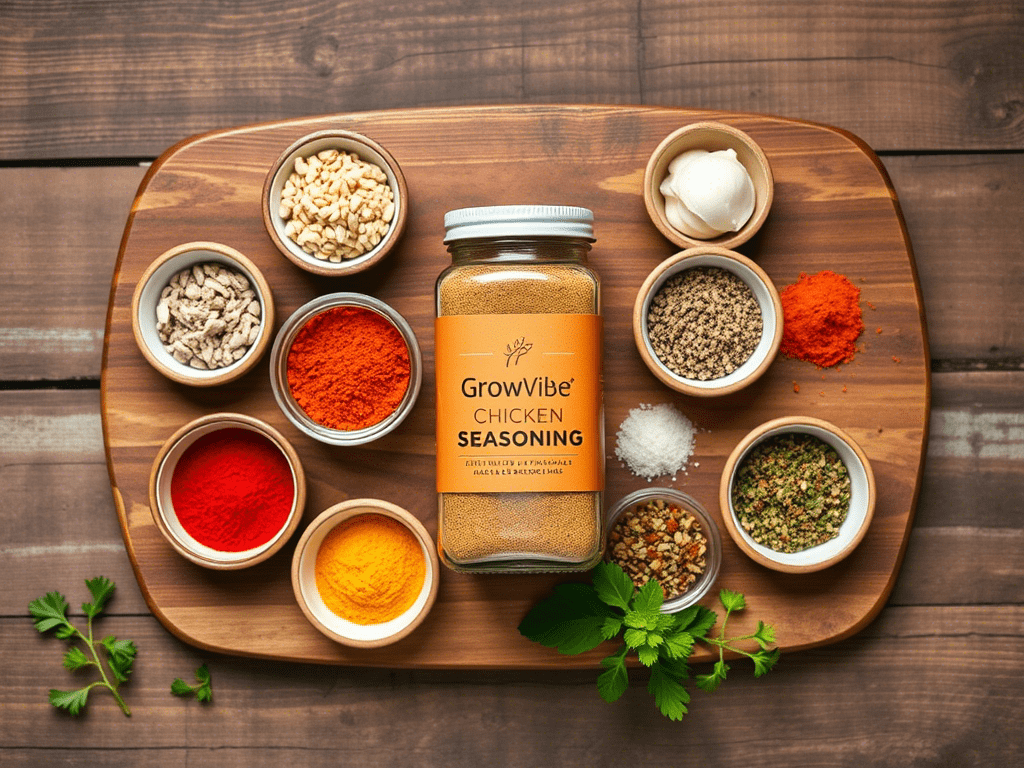10 Bold Chicken Seasoning Blends That’ll Instantly Upgrade Dinner
Let’s be honest, bland chicken is a culinary crime. No matter how juicy it is, if it’s missing flavor, it’s just sad protein on a plate. That’s where chicken seasoning comes in and changes the game.
Chicken is like a blank canvas — it absorbs whatever you give it. But if all you’re tossing on it is a pinch of salt, you’re seriously holding it back. The right blend of herbs and spices can make your chicken taste smoky, spicy, herby, zesty, or even sweet. One simple mix can upgrade your entire meal.
Whether you’re baking, grilling, or air frying, seasoning is what separates basic from bomb. This guide is your shortcut to deliciousness. It’s packed with homemade blends, pro tips, and the best spices for chicken to impress your taste buds and dinner guests alike.
Table of Contents
What Is Chicken Seasoning, Really?
Chicken seasoning is more than just a sprinkle of salt and pepper. It’s a carefully crafted blend of herbs, spices, and aromatics designed to bring out the best in your chicken, no matter how you cook it.
There are three main types of seasoning approaches:
- Dry rubs are mixes of spices applied directly to the chicken. They are perfect for grilling or roasting and help build a flavorful crust.
- Spice blends are similar to dry rubs but often more versatile. You can mix them into marinades or use them in sauces.
- Marinades are liquid-based seasonings that soak into the meat, adding both flavor and moisture.
When people ask, “What’s the difference between a chicken rub and a dry rub?” the answer is simple. A chicken rub is just a dry rub made specifically for poultry. It’s all about balance. If you add too much of one spice, it can overpower the rest. If you use too little, you risk ending up with bland chicken again.
Think of chicken seasoning as your secret weapon. Once you find the right mix, every bite gets better.
Essential Pantry Spices for Every Chicken Dish
Before you start mixing up your next chicken masterpiece, let’s talk about the real MVPs. These are the spices that should always be in your kitchen. They form the foundation of every great chicken seasoning, whether you’re keeping it simple or going full gourmet.
Must-Have Spices for Chicken:
- Paprika (smoked or sweet) for color and depth
- Garlic powder for a savory kick
- Onion powder to round out flavors
- Black pepper to add boldness
- Salt (kosher or sea salt) to enhance everything
- Cumin for warm, earthy undertones
- Dried thyme or oregano for a herbal layer
- Cayenne pepper for heat if you like it spicy
These staples make up the best spices for chicken in almost any cuisine. Mix and match based on your mood or the dish you’re planning. Want something smoky and sweet? Try paprika, brown sugar, and garlic. Craving Mediterranean flavor? Go with oregano, lemon zest, and black pepper.
Start with what you’ve got, taste as you go, and let the chicken do its thing.
Top 10 Chicken Seasoning Blends You Need to Try
No two chicken dinners need to taste the same, and with these 10 powerful blends, they won’t. A great chicken seasoning can completely transform your dish. Whether you’re roasting, grilling, or using the air fryer, these blends will make your chicken unforgettable.
Each one is easy to make with pantry staples and can be used as a chicken rub, dry marinade, or even a quick flavor booster before cooking. Mix them in advance, store in labeled jars, and you’ll always be ready for a flavorful upgrade.
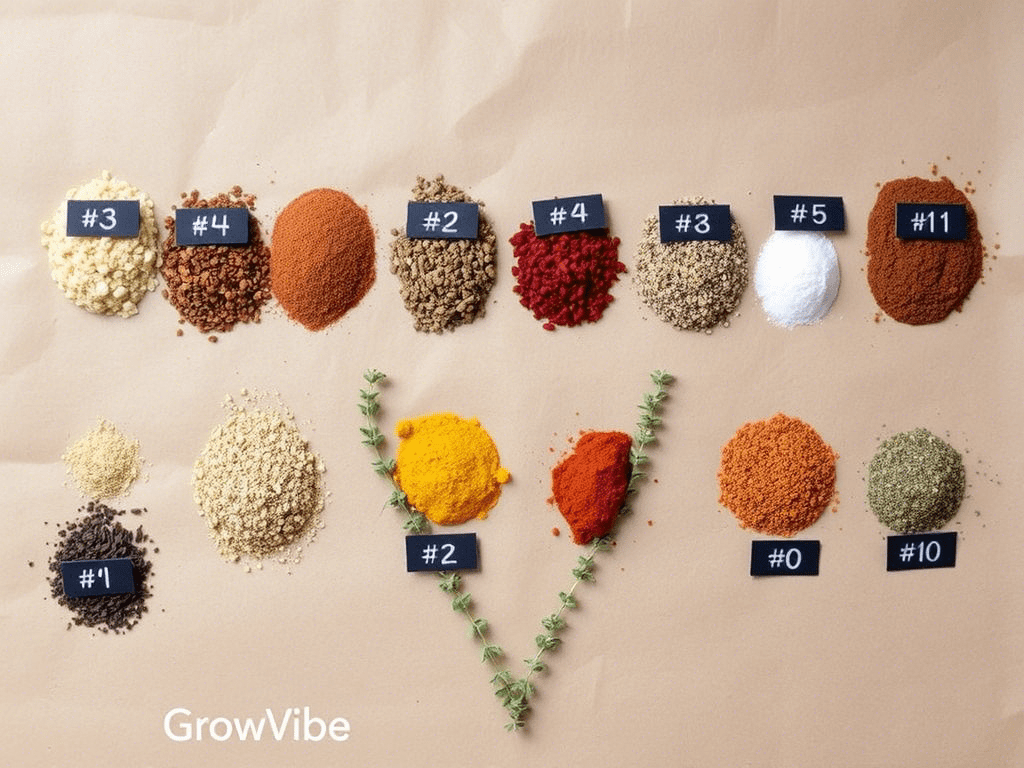
1. Classic Garlic Herb Blend
Perfect for roasted chicken breasts or weekly meal prep.
Ingredients: garlic powder, thyme, oregano, black pepper, and sea salt.
Use this blend as a dry rub or mix with olive oil for a quick marinade.
2. Smoky BBQ Rub
Ideal for grilled drumsticks or oven-baked wings.
Ingredients: paprika, brown sugar, garlic powder, cumin, and chili powder.
This chicken dry rub gives a sweet and smoky depth that sticks to the meat beautifully.
3. Lemon Pepper Zing
Light, citrusy, and perfect for summer.
Ingredients: dried lemon zest, black pepper, garlic powder, and parsley.
Try this seasoning on chicken thighs or wings before air frying.
4. Spicy Cajun Kick
Brings the heat without overwhelming the flavor.
Ingredients: cayenne, smoked paprika, oregano, garlic, and onion powder.
Use this chicken seasoning for bold, fiery results with grilled or fried chicken.
5. Moroccan-Inspired Mix
Warm, fragrant, and deeply flavorful.
Ingredients: cumin, coriander, cinnamon, paprika, and turmeric.
Rub it generously on chicken legs and let it sit for 30 minutes before cooking.
6. Honey Mustard Dry Rub
A sweet and tangy balance in one blend.
Ingredients: dry mustard, garlic powder, brown sugar, and a pinch of cayenne.
This makes a delicious crust when pan-seared or roasted.
7. Italian Herb Seasoning
Classic and cozy.
Ingredients: basil, oregano, rosemary, garlic, and crushed red pepper.
Add to chicken with olive oil and lemon juice for a quick Mediterranean marinade.
8. Tandoori-Style Rub
Aromatic and colorful with deep spice.
Ingredients: paprika, turmeric, coriander, garlic, and ginger powder.
This chicken rub is amazing on grilled skewers or baked thighs.
9. Buffalo Dry Rub
All the flavor of wings without the messy sauce.
Ingredients: cayenne, smoked paprika, garlic, onion powder, and white vinegar powder.
Perfect for a healthier take on buffalo-style chicken.
10. Sweet Chili Lime Rub
Balanced, bright, and a little bit spicy.
Ingredients: chili powder, lime zest, garlic, and a touch of sugar.
Try it with air-fried chicken tenders or crispy baked wings.
Whether you’re new to seasoning or a flavor pro, these blends give you full control over your meals. Just rub them on, rest the chicken for 15 to 30 minutes, and cook using your favorite method.
How to Make the Perfect Chicken Dry Rub at Home
Making your own chicken seasoning at home is easier than you think — and way more flavorful than most store-bought blends. Plus, you control every ingredient, from the salt level to the spice kick.
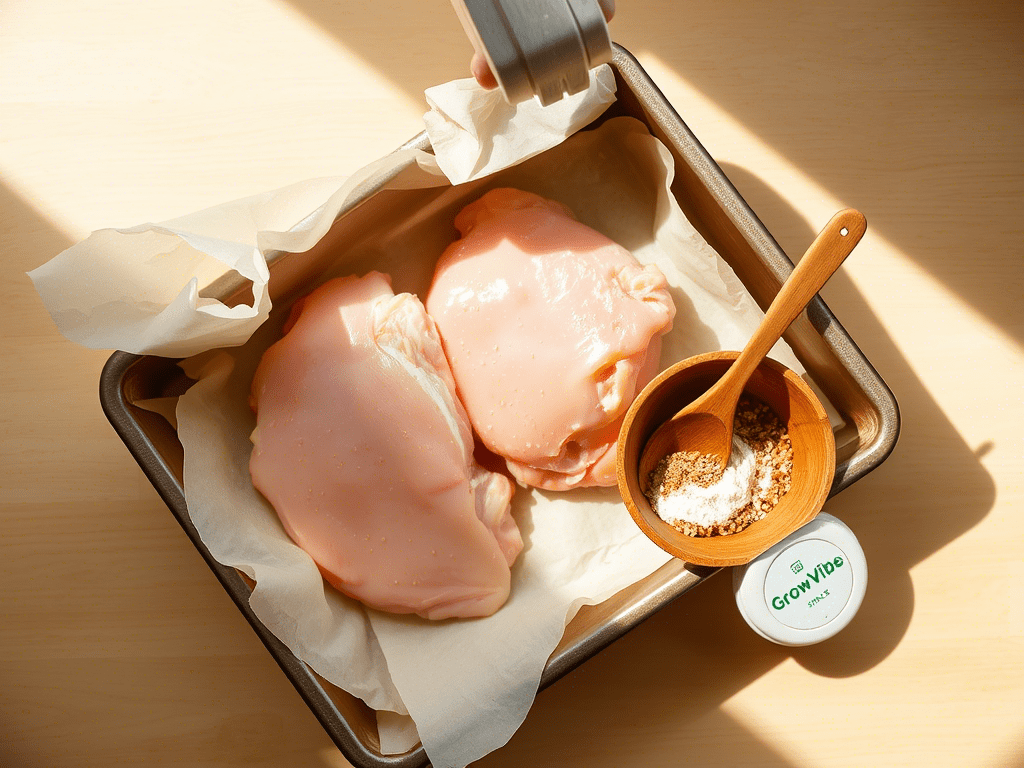
Basic Chicken Dry Rub Recipe
Start with this all-purpose blend that works on everything from chicken breasts to wings:
Ingredients:
- 1 tablespoon paprika
- 1 tablespoon garlic powder
- 1 teaspoon onion powder
- 1 teaspoon dried thyme
- 1 teaspoon cumin
- 1 teaspoon salt
- ½ teaspoon black pepper
- ½ teaspoon cayenne (optional for heat)
How to Use It:
- Pat the chicken dry with a paper towel. This helps the rub stick better.
- Coat generously with the dry rub, pressing it into the meat.
- Let it rest for at least 15 minutes or refrigerate for up to 24 hours.
- Cook as desired: oven, skillet, air fryer — your choice.
This homemade chicken rub creates a flavorful crust and adds deep seasoning to every bite. For an extra twist, you can add brown sugar for sweetness or smoked paprika for that BBQ vibe.
Once you master your own chicken dry rub, you’ll never go back to plain salt and pepper again.
How Do I Season Chicken for Different Cooking Methods?
People often ask, “How do I season chicken for the air fryer?” or “What’s the best way to season grilled chicken?” The truth is, the method matters just as much as the chicken seasoning you use.
Different cooking styles bring out different flavors, and using the right chicken rub can make a huge difference in texture, taste, and moisture. Here’s a quick breakdown of how to get it right every time:
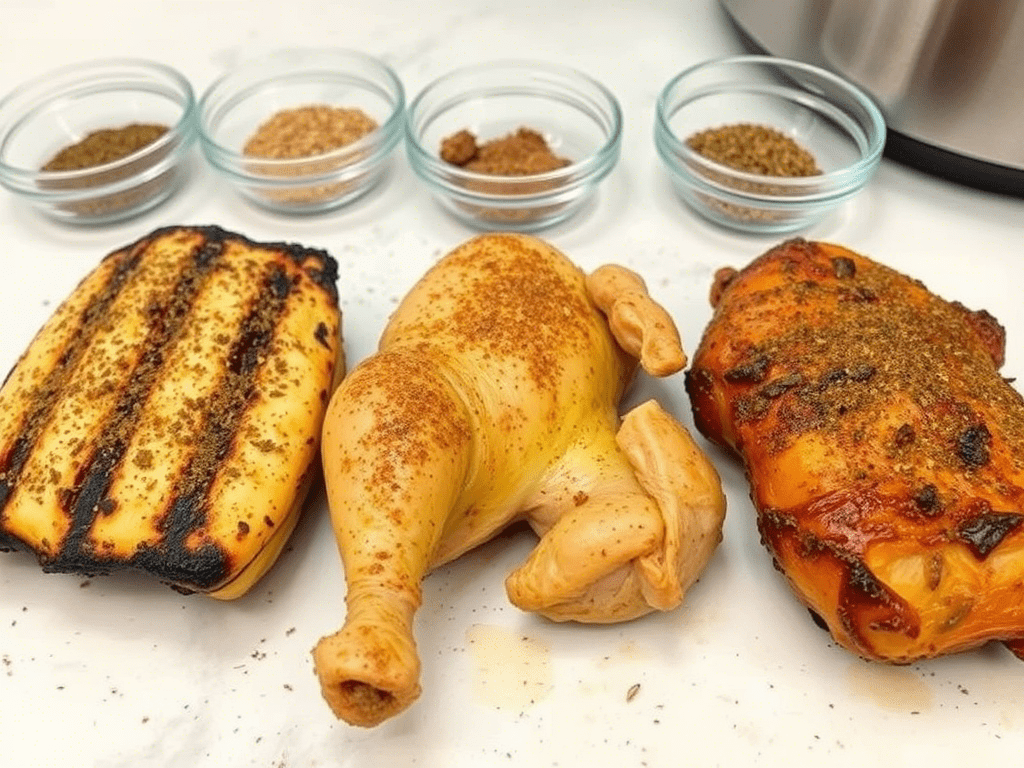
Oven-Baked Chicken
Go for a chicken dry rub that can form a nice crust as it bakes. Think paprika, garlic, onion powder, and a little brown sugar for caramelization. Rub it in thoroughly and let the chicken rest for 15 to 30 minutes before it hits the oven.
Tip: Use a baking rack so air circulates evenly around the meat.
Grilled Chicken
Grill marks and smoky flavor pair beautifully with a bold chicken seasoning. Use a rub with smoked paprika, chili powder, cumin, and black pepper. Add a tablespoon of olive oil to help the seasoning stick and prevent burning. Let your chicken come to room temperature for 20 to 30 minutes before grilling for even cooking.
Air Fryer Chicken
Keep it light but flavorful. A balanced chicken rub with garlic, thyme, paprika, and a touch of cayenne works great. Make sure to pat the chicken dry before seasoning. For extra crispiness, toss the chicken in a teaspoon of cornstarch along with your spice mix.
Pan-Seared or Skillet Chicken
Use spices that handle high heat well. Stay away from blends that include sugar, as they’ll burn quickly in the pan. Try a chicken seasoning mix of herbs, garlic powder, salt, and pepper. You can even add lemon zest after cooking for a fresh finish.
No matter the cooking method, one golden rule applies: season the chicken generously and evenly. Let it sit for at least 10 to 20 minutes before cooking. This gives the flavors time to absorb and stick to the surface, so each bite is juicy and loaded with taste.
Store-Bought Chicken Seasonings Worth Trying
While homemade blends give you full control, sometimes life gets busy. That’s where store-bought chicken seasoning steps in and saves the day. The good news? There are some excellent options on the market that deliver big flavor with zero fuss.
Top Picks for Pre-Made Chicken Rubs:
1. McCormick Grill Mates Montreal Chicken Seasoning
A bold, peppery blend with garlic, paprika, and lemon notes. Ideal for grilled chicken and air fryer recipes.
2. Kinder’s The Blend Seasoning
This all-purpose mix combines salt, pepper, and garlic with extra depth. Works great as a base chicken rub or paired with marinades.
3. Weber Kick’n Chicken Seasoning
Spicy, zesty, and perfect for anyone who wants a little heat without going overboard. Use it on chicken wings, breasts, or skewers.
4. Lawry’s Seasoned Salt for Chicken
A classic option with a savory profile that enhances chicken without overpowering it. Great for quick weeknight meals.
5. Trader Joe’s 21 Seasoning Salute
A salt-free option that still packs a punch. Loaded with herbs, dried veggies, and spices that work beautifully on grilled or roasted chicken.
When shopping for store-bought blends, look at the ingredients. Avoid mixes packed with fillers or high sodium content. The best options stay close to what you’d use in a homemade chicken dry rub.
Bonus tip: Store your seasoning blends in airtight glass jars and keep them in a cool, dry place. This preserves their flavor and makes it easier to reach for them during busy weeknight dinners.
Whether you’re in a rush or just want to experiment, having a few high-quality chicken seasoning mixes on hand is a game-changer. No chopping, no blending, just open and sprinkle.
Mistakes to Avoid When Seasoning Chicken
Even with the best chicken seasoning in hand, small missteps can lead to bland or overpowering results. Mastering the details is what turns good chicken into great chicken.
1. Underseasoning the Chicken
Chicken is naturally mild, so it needs a solid flavor boost. Don’t just sprinkle seasoning on top — coat every part thoroughly. Be generous, especially with bone-in cuts.
2. Using the Wrong Chicken Rub for the Cooking Method
A sweet chicken dry rub might work in the oven but will burn in a hot skillet. Match your seasoning to your method. Go for sugar-free blends for high-heat cooking and more complex rubs for slow roasting.
3. Not Letting the Seasoning Sit
After applying your chicken seasoning, let the meat rest for at least 15 to 30 minutes. This allows the spices to absorb and enhances flavor. Rushing straight to the pan? You’re missing out on depth.
4. Skipping the Salt
Some people use low-sodium blends, which is fine, but completely skipping salt can leave your chicken flat. Salt isn’t just about taste — it helps the seasoning stick and draws moisture into the meat.
5. Seasoning Frozen or Wet Chicken
If the chicken is frozen or damp, your spice mix won’t adhere properly. Always thaw and pat the chicken dry with a paper towel before applying your chicken rub or spice mix.
6. Using Old Spices
Yes, spices expire. If your paprika has lost its color or your cumin smells dusty, it won’t deliver. Always use fresh, aromatic ingredients for maximum flavor impact in your chicken seasoning.
By avoiding these common mistakes, your chicken will turn out flavorful, juicy, and anything but boring. Keep it simple, be generous with your seasoning, and trust your taste buds.
Serving Suggestions: Match Your Seasoning to Your Sides
You’ve nailed the chicken seasoning, now what? Pairing it with the right sides can elevate your meal from just good to restaurant-level. Whether you’re using a bold chicken rub or a simple herb blend, here’s how to make the whole plate shine.
Best Side Pairings by Seasoning Style:
Garlic Herb Chicken
Pairs perfectly with:
- Roasted baby potatoes
- Steamed green beans with lemon
- Garlic butter rice
BBQ or Smoky Chicken Rub
Pairs well with:
- Creamy coleslaw
- Cornbread or grilled corn
- Baked mac and cheese
Lemon Pepper or Mediterranean Seasoning
Goes great with:
- Greek salad with feta
- Couscous or herbed quinoa
- Roasted zucchini and tomatoes
Spicy Cajun or Tandoori-Style Chicken
Perfect with:
- Cool yogurt or tzatziki dip
- Turmeric rice or flatbread
- Cucumber salad or pickled onions
Sweet Chili or Honey Mustard Chicken
Serve with:
- Jasmine rice
- Stir-fried vegetables
- Sesame slaw
When your chicken seasoning has strong flavor notes such as citrus, smoke, or heat, let the sides balance it. Use fresh herbs, citrus, and sauces to layer in contrast and freshness. A great plate is not just about the main, it is about how everything plays together.
Storage Tips for Homemade Seasoning Blends
Once you’ve crafted the perfect chicken seasoning, storing it properly is key to keeping it fresh and flavorful. Spices lose potency over time, especially if exposed to light, heat, or moisture.
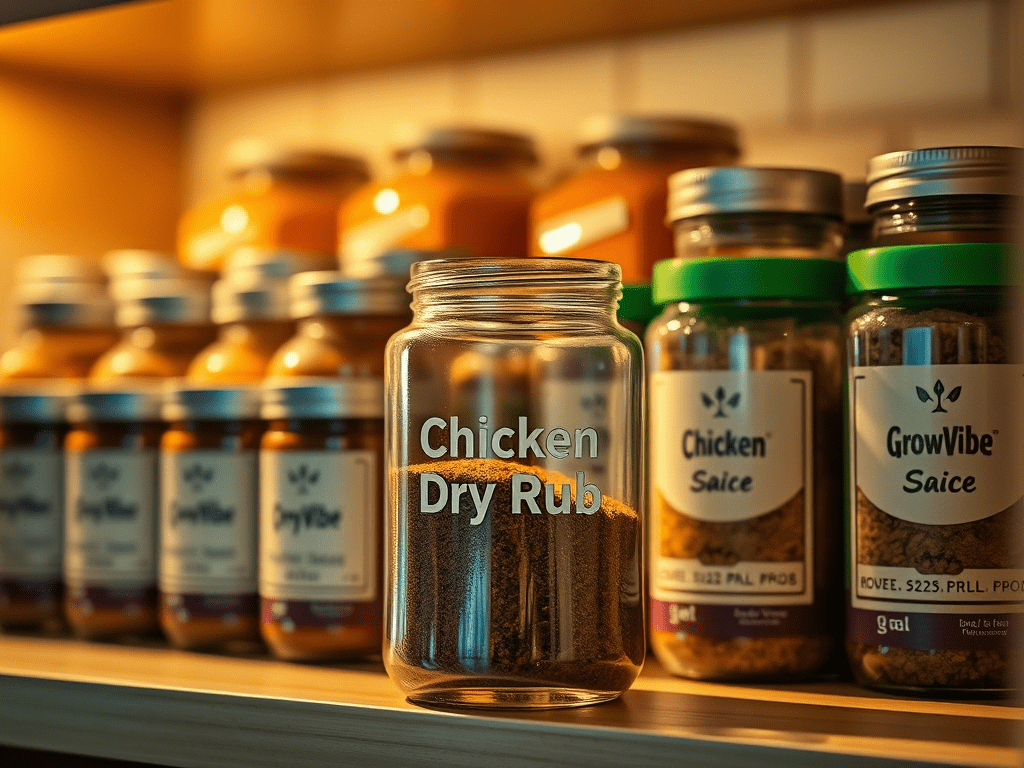
Tips to Store Your Chicken Rub Like a Pro:
1. Use Airtight Glass Jars
Glass containers with tight lids help preserve aroma and flavor. Avoid plastic jars, which can absorb spice odors over time.
2. Label and Date Every Jar
Write the name of the blend and the date you made it. Most chicken dry rubs stay fresh for up to six months, though they’re usually long gone before that.
3. Store in a Cool, Dark Place
Keep your spice jars away from the stove, oven, or direct sunlight. A drawer or pantry is best. Heat and humidity can ruin a good spice mix quickly.
4. Avoid Moisture at All Costs
Don’t shake seasoning directly over steaming food. The moisture can enter the container and cause clumping or spoilage. Use a clean, dry spoon every time.
Bonus Tip: Make Small Batches
Instead of mixing huge quantities, make just enough chicken seasoning to last a month or two. This keeps your blends fresh and flavorful every time you cook.
With the right storage setup, your homemade chicken rub will always be ready to go. No more stale spices or flavorless blends — just reliable, bold taste in every shake.
Bonus Blend: Moroccan-Inspired Chicken Rub
Looking to try something bold, aromatic, and a little different from the usual? This Moroccan-style chicken seasoning brings deep flavor and warmth to any dish. Inspired by traditional North African spices, this blend adds both color and complexity.
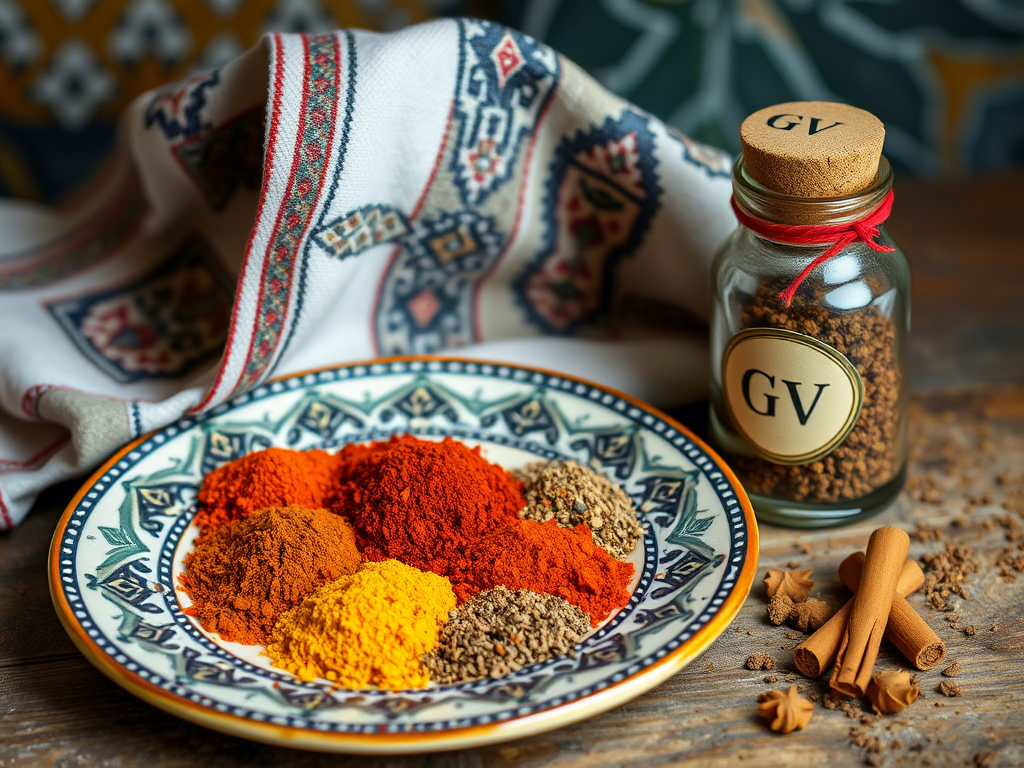
Ingredients:
- 1 tablespoon paprika
- 1 teaspoon ground cumin
- 1 teaspoon ground coriander
- 1 teaspoon turmeric
- 1 teaspoon cinnamon
- 1 teaspoon garlic powder
- ½ teaspoon ginger powder
- ½ teaspoon black pepper
- ½ teaspoon salt
- Pinch of cayenne (optional)
How to Use It:
Rub it generously onto chicken thighs, drumsticks, or even a whole chicken. For maximum flavor, let the chicken rest in the fridge for at least one hour — or overnight if you’ve got time. Then roast, grill, or sear for that golden, spiced crust.
This chicken rub pairs beautifully with couscous, roasted vegetables, or a fresh mint yogurt sauce. The balance of earthy cumin, sweet cinnamon, and warm paprika gives you that authentic Moroccan flair in every bite.
If you’re bored with the usual flavors, this chicken seasoning is the perfect way to change things up without leaving your kitchen.
FAQs: Chicken Seasoning Simplified
1. What is chicken seasoning made of?
A good chicken seasoning typically includes paprika, garlic powder, onion powder, salt, pepper, and dried herbs like thyme or oregano. Some blends add cumin, chili powder, or even a little sugar for a sweet and savory twist.
2. What’s the difference between a chicken rub and a marinade?
A chicken rub is a dry blend of spices applied directly to the surface of the chicken. A marinade, on the other hand, is liquid-based and usually includes ingredients like oil, vinegar, yogurt, or citrus juice to tenderize and flavor the meat.
3. Can I use the same seasoning for all types of chicken?
Yes, but it depends on your cooking method. A single chicken seasoning blend can work for breasts, thighs, wings, or drumsticks. Just adjust the amount and make sure it suits how you plan to cook it — oven, grill, air fryer, or skillet.
4. How far in advance should I season chicken?
Ideally, season it at least 15 to 30 minutes before cooking. For even deeper flavor, especially with a bold chicken rub, you can let it rest in the fridge for several hours or overnight.
5. Can I reuse leftover chicken seasoning?
Only if it hasn’t touched raw meat. Always keep a clean batch separate to avoid cross-contamination. Store unused chicken dry rub in an airtight jar away from heat and light.
Final Thoughts
You’ve now mastered the art of crafting the perfect chicken seasoning, from understanding the basics to exploring diverse blends and cooking methods. To further enhance your culinary journey, here are some additional resources and tools:
Explore More on GrowVibe
- Boneless Skinless Chicken Thighs: 5 Irresistible Oven Recipes
Discover oven-baked recipes that pair wonderfully with your homemade chicken rub. - One-Pan Magic: Chicken Over Rice Recipes
Learn how to create flavorful one-pan meals using your favorite chicken seasoning. - Korean BBQ Sauce: 7 Irresistible Recipes
Add a Korean twist to your dishes with these savory sauce recipes.
Recommended Amazon Products
- McCormick Grill Mates Montreal Chicken Seasoning, 23 oz
A versatile blend perfect for grilling and roasting. - Weber Kick’n Chicken Seasoning, 5 oz Shaker
Adds a spicy kick to your poultry dishes. - 365 by Whole Foods Market, Organic Low Sodium Chicken Broth, 32 fl oz
Enhance the flavor of your meals with this rich broth. - Orii 20 Jar Spice Rack with Spices Included – Stainless Steel
Essential spices to complement your chicken dry rub creations. - Cuisinel Cast Iron Dutch Oven – 5-Quart Deep Pot + Lid + Pan
Ideal for preparing a variety of chicken dishes.
By integrating these resources and tools, you’re well-equipped to elevate your cooking game. Enjoy experimenting with flavors and creating delicious meals!

